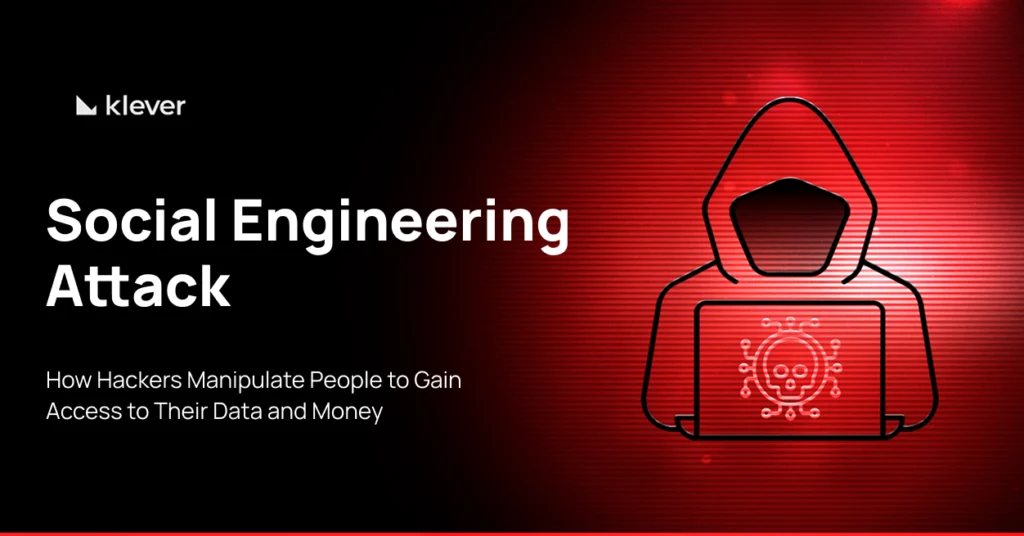
You can have the most advanced antivirus, a configured firewall, and two-factor authentication — and still fall victim to an attack.
Why? Because hackers have realized that the weakest point in digital security isn’t the system — it’s the human.
Social engineering attacks exploit exactly that: trust, fear, urgency, and curiosity.Instead of breaking codes, criminals break people’s focus — convincing them to click on fake links, reveal passwords, or approve seemingly harmless actions.
These manipulations are behind major corporate data breaches, banking scams, and online frauds that move billions of dollars every year. And the most concerning part: victims often don’t even realize they’ve been deceived — until it’s too late.
Learn how the smartest scams begin with a simple message.
What Is a Social Engineering Attack?
A social engineering attack is a psychological manipulation tactic used by criminals to trick people into revealing confidential information, passwords, or performing unsafe actions.
Instead of directly hacking a system, the attacker exploits the weakest link in digital security: human behavior.
The victim believes they are interacting with a trusted source — such as a coworker, bank, technical support agent, or supplier — and ends up granting access to systems, accounts, or sensitive data.
Example: a fake “IT support” email asking for a password confirmation to fix an “urgent error” is a classic example of social engineering.
How Does a Social Engineering Attacks Work?
Social engineering attacks typically follow four main stages, regardless of the channel used:
- Research (Reconnaissance): The attacker gathers information about the victim or organization using social media, websites, and public data.
- Trust Building: Using that information, the attacker impersonates a legitimate person to gain credibility.
- Exploitation: The attacker prompts an action — clicking a link, downloading a file, sharing a password, or sending a payment.
- Execution: Once access is gained, the attacker steals data, installs malware, or carries out financial fraud.
This tactic is effective because it targets human emotions such as fear, curiosity, obedience, and urgency.
Main Characteristics of Social Engineering Attacks
Social engineering attacks share recognizable patterns. Here are the most common characteristics:
- Persuasion and emotional manipulation: use of authority (“I’m from the bank”), fear (“your account will be blocked”), or urgency (“respond within 5 minutes”).
- Personalization: messages include names, job titles, or internal details to increase credibility.
- Use of multiple channels: email, phone calls, SMS, social media, or even in-person interactions.
- Targeted individuals: trusted roles, executives, and support teams are frequent targets.
- Integration with other attacks: social engineering is often the first step before ransomware, phishing, or internal breaches.
Types of Social Engineering Attacks
1. Phishing
Phishing is the most common and widespread type of social engineering attack. In this scheme, the attacker sends fake emails, text messages, or notifications that appear to come from a legitimate source — such as banks, streaming platforms, social networks, or government agencies.
The goal is to trick the victim into clicking a malicious link, downloading an infected file, or providing sensitive information such as passwords, credit card numbers, or banking details.
Example: an email supposedly sent by Netflix claims that “your payment was declined” and asks the user to “update your billing information.” When the victim clicks the link, they are redirected to a fake page identical to the official site — where they unknowingly enter their real login and credit card details.
2. Spear Phishing and Whaling
Spear phishing is a highly targeted version of traditional phishing. Instead of sending generic messages to thousands of people, the attacker focuses on a specific target — such as an employee in a particular department, a financial manager, or someone with access to sensitive data..
Whaling (from the English whale) is an even more sophisticated form of spear phishing that targets high-level executives such as CEOs, CFOs, and directors. The goal is to capture privileged credentials or prompt actions with major consequences, such as authorizing bank transfers, digital signatures, or access approvals.
Example: an email that appears to come from the company’s CFO urgently requests approval for a transfer or the update of credentials in a new internal system.
3. Vishing and Smishing
Not every digital scam arrives by email — many criminals use voice calls and text messages to deceive their victims.
Vishing is a voice-based social engineering attack, where the scammer calls the victim pretending to be from a trusted institution — such as a bank, telecom provider, tech company, or IT support. During the call, the attacker tries to collect sensitive information (like account numbers, passwords, tokens, or authentication codes) or convinces the victim to perform risky actions, such as installing remote access apps.
Smishing refers to phishing carried out through text messages (SMS or WhatsApp). The attacker sends a short message, often containing shortened links, fake promotions, or security alerts, to pressure the victim into clicking quickly. Once the link is clicked, the victim is directed to a cloned website that steals login credentials and financial data — or even installs malware on the device.
Example: the scammer calls pretending to be from the bank’s “fraud prevention department,” warns about a supposed suspicious purchase, and asks the customer to “confirm their details” to block the transaction. Meanwhile, the attacker uses the provided information to access and drain the victim’s account.
4. Pretexting
Pretexting is a form of social engineering attack that relies on creating a convincing and believable story — the so-called “pretext” — to deceive the victim into revealing confidential information or performing specific actions.
Unlike traditional phishing, which typically involves mass emails, pretexting is personalized and carefully planned.
The attacker impersonates a trusted figure — such as an internal employee, supplier, bank representative, HR agent, or IT technician — and builds a coherent narrative to justify the request for information.
Example: “Hi, I’m from HR and need to confirm your Social Security Number to update your employee record.”
5. Baiting
Baiting is a trap that exploits human weaknesses — such as curiosity, greed, or the desire to help — to lure someone into accepting “something of value” that actually contains a hidden threat.
Unlike phishing, which usually relies on messages, baiting uses a physical or digital lure: a “lost” USB drive, a free giveaway, a torrent file, or a link promising a useful download.
Once the victim interacts with the bait — by inserting the USB drive, opening the file, or running the installer — malware is installed, giving the attacker access to the device or network and triggering the next phase of the attack.
6. Quid Pro Quo
Quid pro quo is a social engineering technique based on a direct exchange: the attacker offers a service, help, or apparent benefit in return for information, credentials, or access. Unlike baiting (where the lure is an object or file), quid pro quo uses an active offer of support or advantage — often something that plausibly solves a real problem the target might have.
Example: “I can fix your network issue — I just need your login.”
7. Tailgating / Piggybacking
Instead of hacking digitally, the attacker gains physical access to restricted areas by following someone who is authorized — such as employees, contractors, or visitors.
In essence, the attacker “rides along” on another person’s goodwill — someone who, out of politeness or distraction, holds the door open and lets them in without verifying their authorization.
8. Watering Hole
A watering hole is a social engineering tactic that combines behavioral observation with the compromise of legitimate websites to target a specific audience.
Instead of trying to directly breach a company or individual, the attacker identifies sites the target is likely to visit — such as forums, industry news portals, professional association sites, or corporate intranets — and compromises those pages by injecting malicious code or scripts.
When the victim visits the site as usual, the attack runs without raising suspicion, potentially installing malware, stealing credentials, or exploiting browser vulnerabilities.
9. Scareware
Scareware is a type of social engineering attack that exploits fear and urgency to deceive users.
The tactic is simple but highly effective: the attacker displays fake pop-ups, ads, or virus alerts to make the victim believe that their computer, phone, or browser is infected.
These messages are designed to cause immediate panic — leading the user to download a fake “antivirus” program or pay for a “system cleanup” that, in reality, installs malware instead.
Real Examples of Social Engineering Attacks
Social engineering attacks are not just theoretical — global companies and institutions of all sizes have fallen victim to carefully planned schemes. Here are some of the most notable cases:
Google and Facebook Lost Over $100 Million
Between 2013 and 2015, a Lithuanian scammer named Evaldas Rimasauskas created a fake company posing as a major Asian hardware supplier.
He sent fraudulent invoices to the finance departments of Google and Facebook, using amounts and descriptions identical to legitimate transactions.
Believing they were dealing with a trusted partner, the companies transferred over $100 million to accounts controlled by the scammer.
The case was only uncovered years later, and Rimasauskas was convicted in 2019 — marking one of the largest corporate social engineering frauds ever recorded.
Scattered Spider: The Group That Tricks Tech Support
The hacker group Scattered Spider, active since 2022, became known for attacks based entirely on social engineering.
The criminals called tech support centers pretending to be legitimate employees and successfully convinced help desk agents to reset multi-factor authentication (MFA) and administrative passwords.
In 2023 and 2024, the group was linked to major incidents at companies such as MGM Resorts and Caesars Entertainment, leading to system outages, data theft, and multi-million-dollar losses.
This case shows that even MFA alone isn’t enough if human processes remain vulnerable.
Educational Phishing with Google Classroom
During the second half of 2024, researchers from TechRadar and Proofpoint identified a large-scale phishing campaign targeting teachers and students.
Scammers sent fake Google Classroom invitations that appeared legitimate but redirected users to cloned Google login pages.
When victims entered their credentials, they unknowingly granted attackers full access to their accounts — enabling data theft and the spread of new phishing invitations to other contacts.
This case illustrates how criminals exploit trusted and widely used platforms to make their scams appear legitimate.
Deepfakes Used in Corporate Scams
With the rise of generative artificial intelligence, deepfakes have become a new tool for social engineering attacks.
In 2024, several European companies reported incidents in which criminals created fake videos of executives, simulating urgent requests for financial transfers or internal access approvals.
These AI-generated videos — featuring realistic voices and facial expressions — successfully deceived administrative employees, especially when shared during virtual meetings.
This type of attack marks the new frontier of social engineering, combining advanced technology with emotional manipulation.
How Users Can Protect Themselves of Social Engineering Attacks
- Be skeptical of urgent messages or unusual requests.
- Check the sender and link before clicking.
- Never share passwords or verification codes via email or phone.
- Enable multi-factor authentication (MFA) — preferably using authenticator apps or physical security keys.
- Use strong, unique passwords for each account.
- Keep your systems and antivirus software up to date.
- Avoid downloading unknown attachments or files.
- Verify requests through another channel (phone call, internal message, etc.).
- Report phishing attempts to your security team or email provider.
How to Invest in Corporate Security
Companies that treat security as an investment, not a cost, dramatically reduce their risks. Here are the essential pillars:
- Continuous Training and Simulations
Run awareness campaigns and phishing simulations to test employees’ responses. - Clear Policies and Procedures
Establish approval workflows for transfers, password resets, and other sensitive requests. - Email Security Tools
Implement spam filters, corporate antivirus, and authentication protocols such as SPF, DKIM, and DMARC. - Access and Privilege Control
Apply the principle of least privilege — each employee only accesses what’s necessary for their role. - Strong Authentication
Use phishing-resistant MFA and regularly review user credentials. - Incident Response Plan
Maintain a clear playbook with assigned roles, timelines, and procedures for containment and notification. - Audits and Monitoring
Track suspicious logins, irregular access times, and attempts from new or unrecognized devices. - Vendor Assessment
Evaluate the security and compliance practices of third parties with access to company networks. - Security Culture
Encourage employees to report suspicious activity without fear of punishment.
How to Stay Safe from Social Engineering Attacks?
Social engineering attacks remain one of the biggest threats to digital security — not because of technical flaws, but due to emotional and psychological manipulation.
The most effective defense begins with knowledge, training, and a strong security culture.
By combining these measures, both users and companies can drastically reduce risks and turn the weakest link — the human factor — into their greatest defense.
Stay safe. Be Klever.




